Lambda TCP Tests after Host Upgrade to Linux 2.4
In this document some results are presented obtained with TCP
measurements at the Lambda between SURFnet,
Amsterdam, and StarLight,
Chicago, as part of
the
Netherlight project. The results displayed here are obtained after
-
the upgrade of the ONS.
-
the memory of the hosts located at SARA,
Amsterdam, have been upgraded from 128 MB to 512 MB.
-
the Linux kernel have been upgraded from V. 2.2.15 to
V. 2.4.16-web100.
Due to an unavailability of the Lambda there was unfortunately no time left to
do so far UDP tests after the Linux upgrade. Links to other results can
be find above under the item
"More Result Links:".
The tests were executed between the following hosts:
TCP Tests
For the TCP throughput tests the usual topology has been used with two
VLAN's with two hosts each, ranging from the SSR 8000 at
SARA, Amsterdam, as far as the LSR 6509
at Chicago. The EVL hosts were
located in a third VLAN. The TCP streams at these tests were generated
by Iperf, because this tool
can easily handle multiple streams. A special script has been used to start the
streams at multiple hosts more or less simultaneously using the remote
secure shell mechanism. The details of
these tests are described in the following sections.
VLAN WCW 1 & 2 <=> VLAN EVL
Setup
The throughput tests, described in this subsection, were executed from the
SARA hosts
gwgsara3 in VLAN WCW 1 and
gwgsara5 in VLAN WCW 2 to the
EVL hosts
prusin and reynolds,
both situated in the same VLAN. Also measurements in the reverse direction were
performed. The tests were executed with one and two host pairs. The maximum
window size per host was 16 Mbyte. The test duration per stream was
60 s.
Results
In the 3D figures below the sum of the TCP throughput, taken over
all streams, is presented this setup as a function of the sum of the
TCP window size, also taken over all streams, and of the total
# streams. Source and destination TCP window sizes are chosen
identical.
displays these data for the streams from source host
gwgsara5 to destination host
reynolds. In
these data are given for the reverse direction.
shows these 3D throughput data for the two host pairs in the direction VLAN
WCW 1 & 2 => VLAN EVL, while in
these data are presented for the reverse direction.
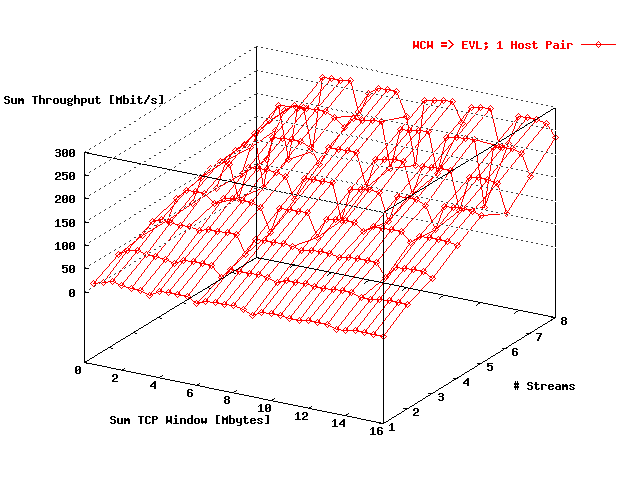
| . |
|
Sum throughput for one host pair in the direction
gwgsara5 =>
reynolds as a
function of the total window size and the
# streams. |

| . |
|
Sum throughput for one host pair in the direction
reynolds =>
gwgsara5 as a
function of the total window size and the
# streams. |

| . |
|
Sum throughput for two host pairs in the direction
WCW 1 & 2 =>
EVL as a function of the total window size and
the # streams. |
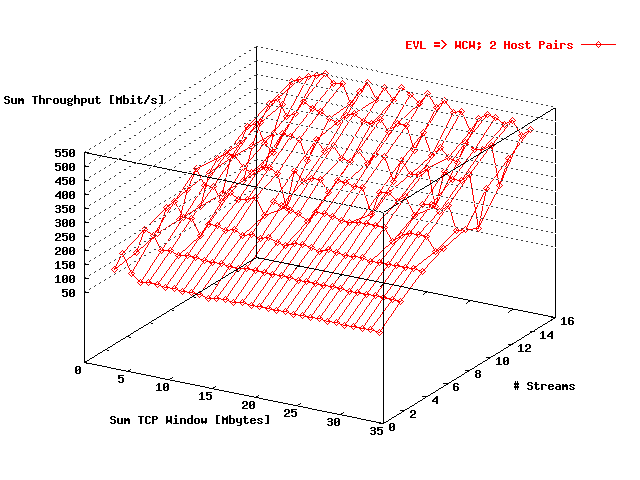
| . |
|
Sum throughput for two host pairs in the direction
EVL =>
WCW 1 & 2 as a function of
the total window size and the
# streams. |
In the figures below the throughput per stream as a function of the TCP
window size is displayed. The data for each # streams are represented in
this plot by a separate trace.
displays these data for the streams from source host
gwgsara5 to destination host
reynolds. In
these data are given for the reverse direction.
shows the throughput per stream data for the two host pairs in the direction
VLAN's WCW 1 & 2 => VLAN EVL, while
in
these data are presented for the reverse direction.

| . |
|
Throughput per stream for one host pair in the
direction
gwgsara5 =>
reynolds as
function of the window size per stream. |
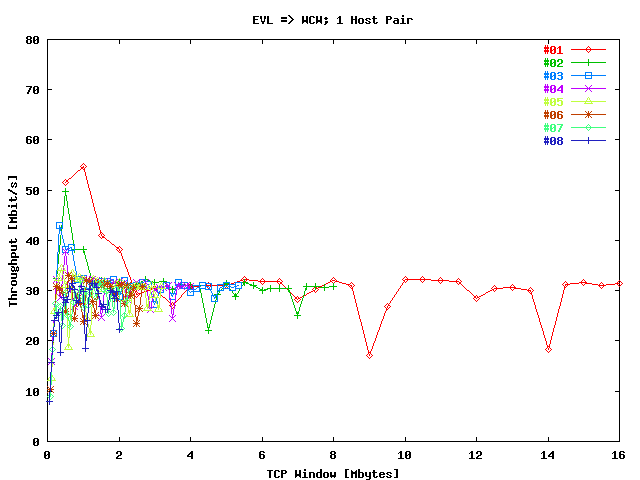
| . |
|
Throughput per stream for one host pair in the
direction
reynolds =>
gwgsara5 as
function of the window size per stream. |
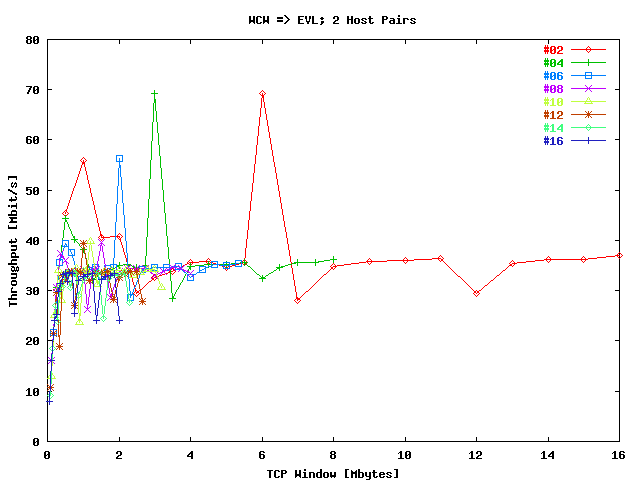
| . |
|
Throughput per stream for two host pairs in the
direction
WCW 1 & 2 =>
EVL as function of the window size per
stream. |
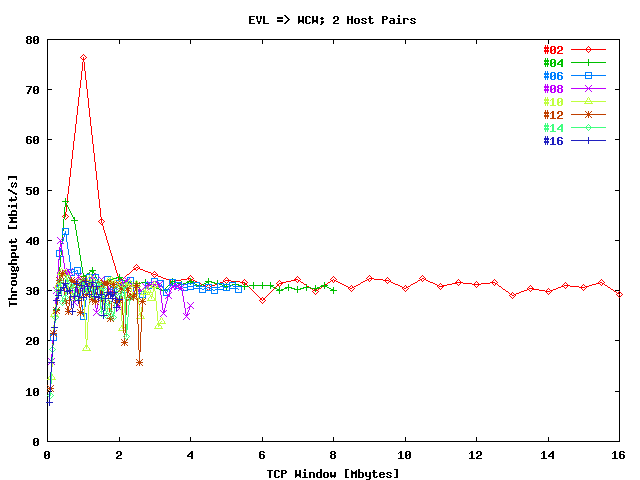
| . |
|
Throughput per stream for two host pairs in the
direction EVL =>
WCW 1 & 2 as function of
the window size per stream. |
Conclusions
The results in the
, ...,
can be compared with the corresponding results
before the Linux upgrade, presented there by the
figures 1,
2,
5,
6,
9, ..., 12.
Comparison of both figures series leads to the following conclusions:
-
The behaviour of the Linux 2.4 leads to a more regular behaviour of the
throughput as function of the TCP window size.
-
However, the performance with the Linux 2.4 kernel seems to be lower
than with the 2.2 kernel. But the tests were performed at different
days, so external influences cannot be excluded.
VLAN WCW 1 <=> VLAN WCW 2
Setup
In this section the results are presented from throughput tests between two
SARA hosts, i.e.
gwgsara3, located in VLAN WCW 1 and
gwgsara5, located in VLAN WCW 2. This
implies that the traffic between these two hosts and VLAN's is following the
route Amsterdam - Chicago - Amsterdam. Also
in these tests the maximum TCP window and socket sizes per host were
16 Mbyte and the test duration was 60 seconds.
Results
In
the sum of the TCP throughput has been presented as a function of the
sum over the TCP window size and the total # streams.
displays these data for the reverse direction.

| . |
|
Sum throughput for one host pair in the direction
WCW 1 => WCW 2 as
a function of the total window size and the
# streams. |

| . |
|
Sum throughput for one host pair in the direction
WCW 2 => WCW 1 as
a function of the total window size and the
# streams. |
gives the mean throughput per stream as function of the TCP window size
for the direction WCW 1 => WCW 2. In
these data are displayed for the reverse direction.
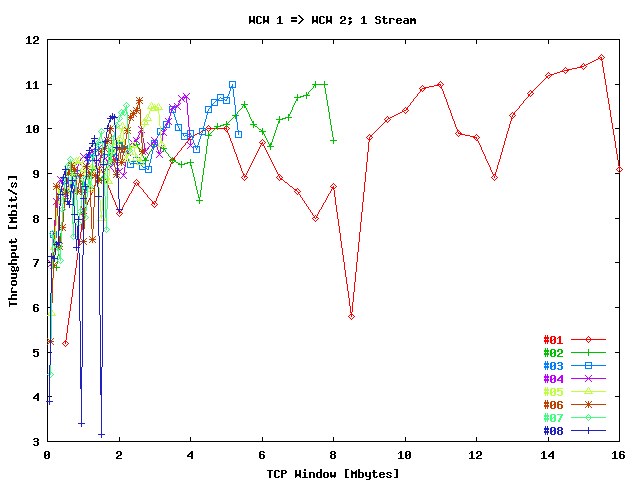
| . |
|
Throughput per stream for one host pair in the
direction WCW 1 =>
WCW 2 as a function of the window size per
stream. |

| . |
|
Throughput per stream for one host pair in the
direction WCW 2 =>
WCW 1 as a function of the window size per
stream. |
Conclusions
The results in the
, ...,
can be compared with the corresponding results
before the Linux upgrade, presented there by the
figures 13, ..., 16. From both figures series the following conclusions can be drawn:
-
The sum throughput plots after the Linux
upgrade
(
and )
show a better and more consistent performance as in the equivalent figures
before the upgrade
(figures 13
and 14).
-
But the plots with the throughput per stream after the Linux upgrade
(
and )
shows a throughput per stream which is in general less than the maximum
values in the corresponding figures before the upgrade
(figures 15
and 16), but the
throughput values before are more consistent, explaining the overall better
throughput performance mentioned above.
-
Also in these results the tests before and after the Linux upgrade were
executed at different days, so daily variations also might have played a
role here.
Bi-Directional Tests VLAN WCW 1 & 2 <=>
VLAN EVL
Setup
This subsection describes the results of bi-directional tests between the
VLAN's WCW 1 & 2 and the EVL VLAN. In these
tests the streams prusin =>
gwgsara3 and
gwgsara5 =>
reynolds were used. Again the maximum window
size per host was 16 Mbyte and the test duration for each stream was
60 s.
Results
displays the sum of the TCP throughput as a function of the sum over
the TCP window size and the total # streams. In
the average throughput per stream has been given as a function of the TCP window
size.
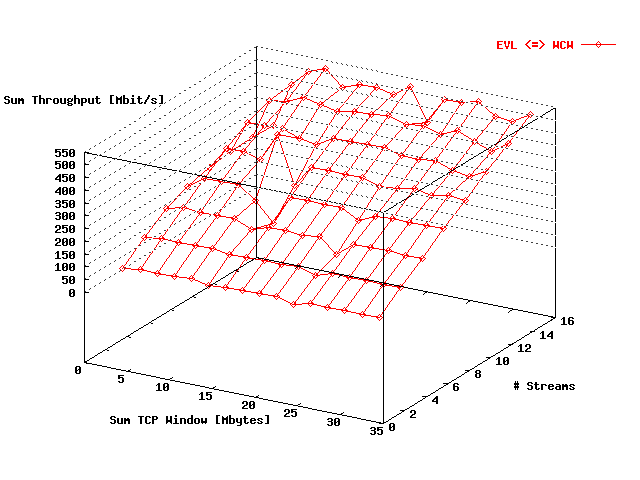
| . |
|
Sum throughput from the bi-directional streams
prusin =>
gwgsara3 and
gwgsara5 =>
reynolds as
a function of the total window size and of the
# streams. |
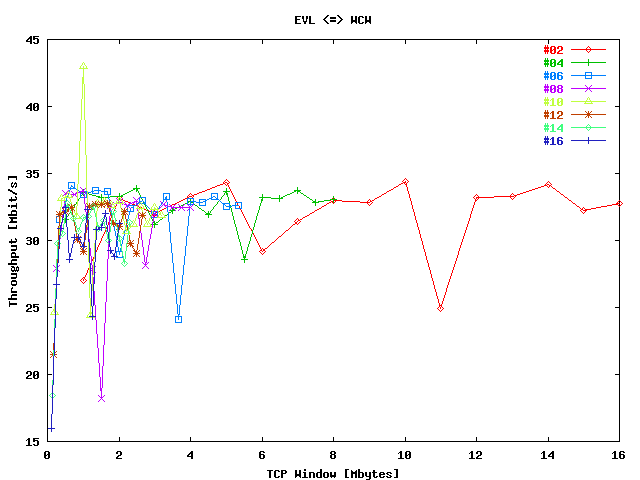
Conclusions
When the bi-direction results from
are compared with the corresponding results for two host pairs from section
"VLAN WCW 1 & 2 <=> VLAN EVL"
(
and )
it follows that the performances of both tests are about the same, reflecting
the full duplex character of the connection. But note that also daily
differences may play a role here.
^^^ Before ONS Upgrade |
^^ Before Memory Upgrade |
^ Before Linux Upgrade













